Reynoutria X Bohemica Chrtek & Chrtková and
Reynoutria X Bohemica Chrtek & Chrtková and
Reynoutria X Bohemica Chrtek & Chrtková and
You also want an ePaper? Increase the reach of your titles
YUMPU automatically turns print PDFs into web optimized ePapers that Google loves.
TWO ALIEN SPECIES IN THE SPREADING PROCESS IN ROMANIA<br />
41<br />
Cercetări Agronomice în Moldova<br />
Vol. XLI , No. 2 (134) / 2008<br />
TWO ALIEN SPECIES IN THE SPREADING<br />
PROCESS IN ROMANIA: REYNOUTRIA X BOHEMICA<br />
CHRTEK & CHRTKOVÁ AND GRINDELIA<br />
SQUARROSA (PURSH) DUNAL<br />
C. SÎRBU 1* , Ad. OPREA 2<br />
1 University of Agricultural Sciences <strong>and</strong> Veterinary Medicine of Iaşi<br />
2 “A. Fătu” Botanic Garden of Iaşi<br />
Received December 21, 2007<br />
ABSTRACT - This paper presents two alien plant species, recently immigrated in Romania<br />
(<strong>Reynoutria</strong> x bohemica <strong>Chrtek</strong> & <strong>Chrtková</strong> <strong>and</strong> Grindelia squarrosa (Pursh) Dunal). For<br />
each species, the following information was provided: occurrence in Romania, way of<br />
migration, their distribution in Romania, Europe <strong>and</strong> other continents, general aspects<br />
regarding their biology, ecology <strong>and</strong> invasive character. <strong>Reynoutria</strong> x bohemica was<br />
mentioned in the flora of Romania by Kovács (2004) <strong>and</strong> Fenesi (2004), as an important<br />
element of the perennial synanthropic vegetation of mesic habitats. In our recent field<br />
investigations (between 2004 <strong>and</strong> 2007), we have also identified this alien species in Moldavia<br />
(Romania), where it was not known until now, especially along watercourses from the<br />
mountainous region (Bistriţa <strong>and</strong> Moldova Rivers). Moreover, the study of samples from some<br />
herbaria (I, IAGB <strong>and</strong> IASI) allowed us to find out that, although the occurrence of this species<br />
in Romania was discovered a short time ago, it had already been collected since the second<br />
half of the last century, but was erroneously determined as Polygonum cuspidatum Sieb. &<br />
Zucc. In the conquered habitats, <strong>Reynoutria</strong> x bohemica manifested a marked invasive<br />
character, forming well-developed phytocoenoses (2-4 m high <strong>and</strong> 100% coverage), which<br />
replaced the native vegetal communities on large areas. The second species, Grindelia<br />
squarrosa (reported in 1998 for the first time in the flora of Romania), can be also considered<br />
as an invasive alien plant in Romania. It invaded the disturbed habitats (especially ruderal<br />
places in the proximity of railways), both in the North-East <strong>and</strong> South of Moldavia (Iaşi <strong>and</strong><br />
Galaţi).<br />
Key words: alien plants, plant invasion, Romania, vascular flora, weeds<br />
* E-mail: culita69@yahoo.com
C. SÎRBU, Ad. OPREA<br />
REZUMAT - Două specii adventive pe cale de răspândire în România: <strong>Reynoutria</strong> x<br />
bohemica <strong>Chrtek</strong> & <strong>Chrtková</strong> şi Grindelia squarrosa (Pursh) Dunal. Lucrarea prezintă două<br />
specii de plante adventive recent imigrate în România (<strong>Reynoutria</strong> x bohemica <strong>Chrtek</strong> &<br />
<strong>Chrtková</strong> şi Grindelia squarrosa (Pursh) Dunal). Pentru fiecare specie, sunt redate<br />
următoarele informaţii: prezenţa în România, calea de migraţie, răspândirea în România, în<br />
Europa şi în alte continente, aspecte generale privind biologia, ecologia şi caracterul lor<br />
invaziv. <strong>Reynoutria</strong> x bohemica a fost menţionată în flora României de către Kovács (2004) şi<br />
Fenesi (2004), de-a lungul unor cursuri de apă din Transilvania, ca un element important al<br />
vegetaţiei perene sinantropice din habitate mezice. În cercetările noastre recente de teren<br />
(între 2004 şi 2007), am identificat această specie adventivă şi în Moldova (România), unde nu<br />
era cunoscută până în prezent, în principal de-a lungul unor cursuri de apă din regiunea<br />
montană (râurile Bistriţa şi Moldova). Mai mult, examinarea specimenelor din unele herbarii<br />
(I, IAGB, IASI) ne-a permis să constatăm că, deşi prezenţa acestei specii în România a fost<br />
descoperită de scurtă vreme, ea a fost colectată încă din a doua jumătate a secolului trecut,<br />
dar determinată eronat ca Polygonum cuspidatum Sieb. & Zucc. În habitatele invadate,<br />
<strong>Reynoutria</strong> x bohemica manifestă un marcant caracter invaziv, formând fitocenoze bine<br />
dezvoltate (de 2-4 m înălţime şi acoperire de 100%), ce înlocuiesc comunităţile vegetale native<br />
pe mari suprafeţe. Cea de-a doua specie, Grindelia squarrosa (raportată în 1998 pentru prima<br />
oară în flora României), poate fi, de asemenea, considerată o plantă invazivă în România. Ea<br />
invadează habitatele perturbate (în principal locurile ruderale din vecinătatea căilor ferate),<br />
atât în nord-estul, cât şi în sudul Moldovei (Iaşi şi Galaţi).<br />
Cuvinte cheie: plante adventive, invazia plantelor, România, flora vasculară, buruieni<br />
INTRODUCTION<br />
The invasive alien species are largely recognized as a major threat to the<br />
native biodiversity (Pauchard & Alaback, 2006), ecosystem structure <strong>and</strong><br />
functions (Levine et al. 2003, Zedler & Kercher, 2004; Stinson et al. 2006) <strong>and</strong><br />
conservation of the protected areas (Pauchard & Alaback, 2006), requiring<br />
enormous costs in agriculture, forestry, fisheries <strong>and</strong> other human activities, as<br />
well as in human health (Pimentel et al., 2000; Wittenberg & Cock, 2001; Lowell &<br />
Stone, 2005, etc).<br />
This paper refers to two alien plant species, which have recently<br />
immigrated into the Romanian flora: <strong>Reynoutria</strong> x bohemica <strong>and</strong> Grindelia<br />
squarrosa.<br />
MATERIALS AND METHODS<br />
The presence, distribution in Romania <strong>and</strong> invasive character of these two plant<br />
species are based on our recent field investigations (2004-2007). Data from some<br />
herbarium collections (I, IAGB <strong>and</strong> IASI) <strong>and</strong> information from the literature were also<br />
used. The herbarium samples have been stored in the general herbarium of the University<br />
of Agricultural Sciences <strong>and</strong> Veterinary Medicine of Iaşi.<br />
42
TWO ALIEN SPECIES IN THE SPREADING PROCESS IN ROMANIA<br />
RESULTS AND DISCUSSION<br />
1. <strong>Reynoutria</strong> x bohemica <strong>Chrtek</strong> & <strong>Chrtková</strong>, Čas. Nár. Muz. Praha, ser.<br />
nat., 152: 120 (1983) (=<strong>Reynoutria</strong> japonica x <strong>Reynoutria</strong> sachalinensis) (Syn.:<br />
Fallopia x bohemica (<strong>Chrtek</strong> & <strong>Chrtková</strong>) J. Bailey; Polygonum × bohemicum<br />
(<strong>Chrtek</strong> & <strong>Chrtková</strong>) Zika & Jacobson).<br />
Although known for a short time in Romania (Kovács, 2004; Kovács,<br />
2006), <strong>Reynoutria</strong> x bohemica has already been identified in over 78 localities<br />
from Eastern Transylvania, being designated as recognition species (together with<br />
<strong>Reynoutria</strong> japonica) for the perennial synanthropic vegetation of mesic habitats<br />
(Galio-Urticetea), of “Fallopia japonica agg. (DC.)” type, which are frequent in<br />
this part of the country (Kovács, 2004; Kovács, 2006; Fenesi 2004).<br />
We found this species (initially, determined as <strong>Reynoutria</strong> japonica) (Oprea<br />
& Sîrbu, 2006), three years ago (2004), on the left bank of the Tisa River (the<br />
Romanian side), between the villages Valea Vişeului <strong>and</strong> Piatra, then in Lăpuş<br />
Gorges, Valea Vinului, Rodna (2006), <strong>and</strong>, recently, in the Arieş Valley -<br />
Apuseni Mountains (2007).<br />
Along these watercourses, <strong>Reynoutria</strong> x bohemica presents a marked<br />
invasive character, forming (together with <strong>Reynoutria</strong> japonica, Helianthus<br />
tuberosus, Solidago gigantea subsp. serotina, Rubus caesius, Artemisia vulgaris,<br />
Erigeron annuus s.l., Tanacetum vulgare, Agrostis stolonifera, as companions)<br />
well-developed phytocoenoses (2-4 m high <strong>and</strong> 100% coverage), which replace<br />
the native vegetal communities on large areas (Oprea & Sîrbu, 2006).<br />
In Moldavia (between the Eastern Carpathians <strong>and</strong> the Prut River), this<br />
species has not been known until now. As a result of our recent field<br />
investigations, we have also found this species in this province, mainly along the<br />
riverside in the mountain regions - along the Bistriţa River <strong>and</strong> its effluents (at<br />
Vatra Dornei, Pietroasa, Crucea, Broşteni, Galu, Piatra Neamţ, Ceahlău, Bicaz,<br />
Bicazul Ardelean, Bicaz-Chei, Ticoş, Taşca) (leg. Sîrbu & Oprea, 2004-2007),<br />
Moldova River (at Gura Humorului, Negrileasa), but also in the Moldavian Plain<br />
(in Iaşi, escaped from culture, on the Florilor Street, leg. Sîrbu, 2006).<br />
Moreover, examining some herbarium materials, we have noticed that,<br />
although the occurrence of this species in Romania was discovered a short time<br />
ago, it had been collected since the second half of the last century, but erroneously<br />
determined as Polygonum cuspidatum Sieb. & Zucc., as in the following<br />
instances: Lunca Bistricioarei (Neamţ County) (leg. Zanoschi 1969, Herb. IASI-<br />
13385); Lacu Roşu (Harghita County) (leg. Burduja. & Sârbu 1969, Herb. I-<br />
42894; Ţopa 1973, Herb. IAGB 29442); Lacu Roşu-Pârâul Oilor (Harghita<br />
County) ( leg. Dobrescu 1969, Herb. I-50687; 50688); Baia Mare (Maramureş<br />
County) (leg. Ţopa 1969, Herb. IAGB-3970), Gurahonţ (Arad County) (leg. Ţopa<br />
1941, Herb. IAGB-28537), etc.<br />
43
C. SÎRBU, Ad. OPREA<br />
Taking into consideration the above aspect, it is possible that many<br />
chorological data referring to <strong>Reynoutria</strong> japonica (=Polygonum cuspidatum)<br />
from Romania must be reconsidered <strong>and</strong> assigned to <strong>Reynoutria</strong> x bohemica. As a<br />
result, we consider that the real spreading of this plant in Romania is not<br />
completely known yet, further investigations for establishing its real invasive area<br />
being necessary.<br />
Description. <strong>Reynoutria</strong> x bohemica is distinct from <strong>Reynoutria</strong> japonica<br />
(with which it was confused in Romania, in the past) by a bigger habitus (- 4 m<br />
high), bigger leaves (up to 23 cm long <strong>and</strong> 19 cm wide) with slightly cordate or<br />
truncated base, <strong>and</strong> 2-3-cellular, acute hairs on the veins from the underside of<br />
leaf (Figure 1).<br />
<strong>Reynoutria</strong> japonica has not hairs on its leaves, but heavily ornamented<br />
single cells (Bailey et al., 1996); panicle is commonly shorter than the subtending<br />
leaf length (Barney et al., 2006).<br />
Fig. 1 - <strong>Reynoutria</strong> x bohemica: hairs on the underside of leaf<br />
Historical considerations <strong>and</strong> general spreading. In 1983, <strong>Chrtek</strong> &<br />
<strong>Chrtková</strong> described <strong>Reynoutria</strong> x bohemica from the Central Bohemia (Czech<br />
Republic), as a new species in science. Nevertheless, its presence in Europe dated<br />
since the second half of the 19 th century. In 1872, it was cultivated in English<br />
gardens (under one of its parents’ names), the oldest herbarium records<br />
originating from the Manchester Botanic Garden (Bailey & Conolly, 2000 quoted<br />
by M<strong>and</strong>ák et al., 2004). In the Czech Republic, there were data about the<br />
presence of this species (cultivated as ornamental) since 1942 (Pyšek et al.,<br />
2002), but at present, in this country, <strong>Reynoutria</strong> x bohemica is reported as a wild<br />
plant in over 381 localities (M<strong>and</strong>ák et al., 2004).<br />
44
TWO ALIEN SPECIES IN THE SPREADING PROCESS IN ROMANIA<br />
Nowadays, it is cited in the majority of the central <strong>and</strong> western European<br />
countries: Great Britain <strong>and</strong> Irel<strong>and</strong> (Webb, 1993; Bailey et al., 1996), Czech<br />
Republic (<strong>Chrtek</strong> & <strong>Chrtková</strong>, 1983; M<strong>and</strong>ák et al., 2004), Slovakia (Eliaš et al.,<br />
2001; Eliáš ,2004), Pol<strong>and</strong> (Fojcik & Tokarska-Guzik, 2000), France (Kerguélen,<br />
1993; Brunel & Tison, 2005; Schnitzler & Bailey, 2005), Switzerl<strong>and</strong> (Gerber,<br />
2006; Shaw & Schaffner, 2006), Belgium (Tiébré & Mahy, 2005), Germany<br />
(Kowarik & Schepker, 1998), Hungary (Balogh, 1988, cited by Balogh & Bailey,<br />
2003; Balogh, 2003), as well as in Bulgaria (Vladimirov, 2005) <strong>and</strong> Ukraine (Tisa<br />
Basin) (Drescher et al., 2003). It is also known in North America (Zika &<br />
Jacobson, 2003; Barney et al. 2006, FNA) <strong>and</strong> Japan (Bailey, 2003, cited by<br />
M<strong>and</strong>ák et al., 2004).<br />
The immigration way in Romania. Regarding the way of this species<br />
immigration in Romania, there are two hypotheses: either it was directly imported<br />
from Central Europe (under the name of <strong>Reynoutria</strong> japonica or Polygonum<br />
cuspidatum), to be cultivated as ornamental, <strong>and</strong> then it escaped from gardens, or<br />
it spread on natural ways from west to east, along watercourses (Tisa, Someş,<br />
Mureş, etc.), first in Transylvania, then in Moldavia, along the intra-mountain<br />
corridors.<br />
Biology <strong>and</strong> ecology. <strong>Reynoutria</strong> x bohemica is a geophyte (with rhizome),<br />
generally hexaploid (2n=66) (but tetraploid <strong>and</strong> octoploid clones may also be<br />
found) (Bailey et al., 1996; M<strong>and</strong>ák et al., 2003), mezophyllousmezohigrophyllous;<br />
it flowers during July-October. The flowers are<br />
hermaphrodite or female; the hermaphrodite ones are generally self-incompatible,<br />
that is they are unable to form seed without an additional source of pollen (Bailey<br />
et al., 1996; Balogh & Bailey, 2003).<br />
The main mode of reproduction is the vegetative one (with rhizomes, less<br />
aerial stems) (Bímová et al., 2003; Pyšek et al., 2003; Balogh & Bailey, 2003;<br />
M<strong>and</strong>ak et al., 2004), but the regeneration rate <strong>and</strong> final shoot mass are<br />
significantly affected by genotype (Pyšek et al., 2003).<br />
It invades riparian habitats, especially riversides <strong>and</strong> various anthropic<br />
disturbed habitats (roadsides, railways, waste places, uncultivated fields, etc.); it<br />
often spreads the natural or semi-natural vegetation (M<strong>and</strong>ák et al., 2003; Zika &<br />
Jacobson, 2003; Balogh & Bailey, 2003; Gerber, 2006; Kovács, 2004; Kovács,<br />
2006; Fenesi, 2004; Oprea & Sîrbu, 2006). It is more frequent in hilly (Balogh &<br />
Bailey, 2003) or mountainous regions.<br />
From the phytocoenological point of view, the populations of this species<br />
enter the structure of some vegetal communities of Galio-Urticecea class,<br />
Convolvuletalia sepium order, Senecion fluviatilis alliance (Kovács, 2004;<br />
Kovács, 2006; Fenesi, 2004; Oprea & Sîrbu, 2006).<br />
The invasive character. Together with its parental species, native from<br />
East Asia, <strong>Reynoutria</strong> x bohemica is one of the most important invasive species in<br />
Europe (Balogh & Bailey, 2003, M<strong>and</strong>ák et al., 2003) <strong>and</strong> North America (Zika &<br />
45
C. SÎRBU, Ad. OPREA<br />
Jacobson, 2003; FNA), replacing all other vegetation from the invaded habitats.<br />
In many European countries, the deliberate spread in the environment of these<br />
species is rigorously prohibited (Shaw & Schaffner, 2006).<br />
2. Grindelia squarrosa (Pursh) Dunal. Mémoires du Museum d'Histoire<br />
Naturelle. Paris, 5: 50 (1819) (Syn.: Donia squarrosa Pursh, Fl. Am. Sept. II. 559<br />
(1814)) (Figure 2).<br />
Fig. 2 – A-Ruderal vegetation with Grindelia squarrosa at Galaţi (E Romania); B-<br />
Detail with anthodiums<br />
Native from North America, where it is a common weed of prairies (Britton<br />
& Brown, 1970; Correll & Johnston, 1970; Darbyshire, 2003), it was introduced<br />
in Europe in 1804, as a cultivated plant, in the Royal Garden of Madrid (under the<br />
name of Aster spathulatus Hort.) (Steyermark, 1937). Nevertheless, it seems that<br />
in Europe its naturalization took place only to the middle of the last century, when<br />
it was reported as a wild plant (in 1949) in the Ukraine-Mykolayiv Region<br />
(Protopopova et al., 2006).<br />
At present, the immigration domain of this species includes a significant<br />
part from Eastern, Central <strong>and</strong> Western Europe, being introduced into the<br />
following countries: Russia (C, E) (naturalized) (Tamamşian, 1959; Hansen,<br />
1976; Greuter, 2005-2007), Ukraine (invasive) (Protopopova & Shevera, 1999;<br />
Mosyakin & Yavorska, 2002), Republic of Moldova (invasive) (Mîrza et al.,<br />
1987), Estonia (casual) (Kukk, 1999), Lithuania (casual) (Gudzinskas, 1997),<br />
Czech Republic (casual) (Kubát et al., 2002, cited by Pyšek et al., 2002),<br />
Belgium, Sweden, Latvia (casual) (Greuter, 2005-2007), Irel<strong>and</strong> (casual)<br />
(Reynolds, 2002).<br />
In Ukraine <strong>and</strong> Republic of Moldova, Grindelia squarrosa is considered a<br />
very aggressive plant; here, it is naturalized in steppe, petrophytic, coastal,<br />
46
TWO ALIEN SPECIES IN THE SPREADING PROCESS IN ROMANIA<br />
riparian, xerophytic <strong>and</strong> shrubby communities, pastures, ab<strong>and</strong>oned arable l<strong>and</strong>s,<br />
<strong>and</strong> severely degraded habitats, along roadsides <strong>and</strong> railways, as well as in the<br />
river basins (Protopopova & Shevera, 1999; Protopopova et al., 2006; Mîrza et<br />
al., 1987; Negru (ed) 2006), or even in natural reservations (Ursu (ed) 2005).<br />
It is also considered as potentially invasive in Spain (Sanz Elorza et al.,<br />
2001).<br />
In Romania, this species has been recently identified in the ruderal places<br />
of the siding lines from the Socola-Iaşi railway station (Sîrbu & Oprea, 1998;<br />
Ciocârlan, 2000; Sîrbu, 2004; Oprea, 2005). Meantime, the population from the<br />
Socola-Iaşi station has been notable extended, conquering an area of thous<strong>and</strong><br />
square meters <strong>and</strong> becoming an important constituent of the anthropic vegetation<br />
from those ruderal places.<br />
Recently, in September 2006, we have also found this species in the South<br />
of Moldavia (Romania), at Galaţi, where it vegetates under prosperous conditions,<br />
on some tens of hectares, along railway embankment, as well as on ruderal places<br />
around railway, along Portului Street, <strong>and</strong> the surroundings of Galaţi-Larga<br />
station. We suppose that in this location, as well as in Socola-Iaşi, this plant<br />
arrived from the Republic of Moldova, with goods or passenger trains.<br />
At present, Grindelia squarrosa can be thus considered fully naturalized in<br />
Romania, having an evident invasive character.<br />
CONCLUSIONS<br />
This paper is a contribution to the knowledge of the distribution of two<br />
alien species (<strong>Reynoutria</strong> x bohemica, <strong>and</strong> Grindelia squarrosa), both recently<br />
detected in the flora of Romania.<br />
<strong>Reynoutria</strong> x bohemica, known in Europe as a very important invasive<br />
species, is cited now for the first time in Moldavia (between the Eastern<br />
Carpathians <strong>and</strong> the Prut River). <strong>Reynoutria</strong> x bohemica presents a strong<br />
invasive character, forming well-developed phytocoenoses, which replace the<br />
native vegetal communities on large areas, especially along watercourses, in<br />
Transylvania <strong>and</strong> in Moldavia.<br />
Grindelia squarrosa, previously reported in 1998, at the Socola-Iaşi<br />
railway station (for the first time in the flora of Romania), was also found, in<br />
2006, at Galaţi, in the Southern Moldavia (Eastern Romania), where it presents an<br />
evident invasive character in the anthropic habitats.<br />
REFERENCES<br />
Balogh L., 2003 - A Fallopia nemzetség <strong>Reynoutria</strong> szekciója Magyarországon elöforduló<br />
fajainak határozókulcsa. Flora Pannonica 1(1): 76-88<br />
Balogh L., Bailey J., 2003 - Species of the genus Fallopia sectio <strong>Reynoutria</strong> in Hungary -<br />
a l<strong>and</strong> of the hybrid Fallopia x bohemica ? Abstracts of the 7 th International<br />
47
C. SÎRBU, Ad. OPREA<br />
Conference on the Ecology <strong>and</strong> Management of Alien Plant Invasions, Florida,<br />
USA, 3-7 Nov.<br />
Bailey J.P., Child L.E., Conolly A.P., 1996 - A survey of the distribution of Fallopia x<br />
bohemica (<strong>Chrtek</strong> & <strong>Chrtková</strong>) J. Bailey (Polygonaceae) in the British Isles.<br />
Watsonia 21: 187-198<br />
Barney J.N., Tharayil N., Ditommaso A., Bhowmik P.C., 2006 - The biology of invasive<br />
alien plants in Canada. 5. Polygonum cuspidatum Sieb. & Zucc. [= Fallopia japonica<br />
(Houtt.) Ronse Decr.]. Can. J. Plant Sci. 86: 887-905<br />
Bímová K., M<strong>and</strong>ák B., Pyšek P., 2003 - Experimental study of vegetative regeneration in<br />
four invasive <strong>Reynoutria</strong> taxa (Polygonaceae). Plant Ecology 166 (1): 1-16<br />
Britton N., Brown A., 1970 - An illustrated flora of the Northern United States <strong>and</strong><br />
Canada, I-III. Dover Publ. Inc. New York<br />
Brunel S., Tison J-M., 2005 - A method of selection <strong>and</strong> hierarchization of the invasive<br />
<strong>and</strong> potentially invasive plants in continental Mediterranean France. In: Brunel S<br />
(ed), Invasive plants in Mediterranean type regions of the world. Proc. Internat.<br />
Workshop, Mèze, France, 25-27 May 2005. Council of Europe Publ. 27-36<br />
<strong>Chrtek</strong> J., <strong>Chrtková</strong> A., 1983 - <strong>Reynoutria</strong> × bohemica, nový kříženec z ćeledi<br />
rdesnovitých. Čas. Nár. Muz. Praha, ser. nat. 152: 120<br />
Ciocârlan V., 2000 - Flora ilustrată a României. Pteridophyta et Spermatophyta. Bucureşti,<br />
Edit. Ceres, pp 1138<br />
Correll D.S., Johnston M.C., 1970 - Manual of the vascular plants of Texas. Renner,<br />
Texas, pp 1881<br />
Darbyshire S.J., 2003 - Inventory of Canadian Agricultural Weeds. Agriculture <strong>and</strong> Agri-<br />
Food Canada, Research Branch, Ottawa, Ontario<br />
Drescher A., Prots B., Mountford O., 2003 - The world of old oxbowlakes, ancient<br />
riverine forests <strong>and</strong> drained mires in the Tisza river basin (International excursion to<br />
Eastern Hungary <strong>and</strong> Transcarpathia, Ukraine 31.08.- 04.09.2002). Fritschiana<br />
(Graz) 45: 43-69<br />
Eliaš P., Feher A., Koncekova L., Lisyova J., Paukova Z., 2001 - Population - ecological<br />
studies of harmful / problematic invasive alien species (Impatiens parviflora, I.<br />
gl<strong>and</strong>ulifera, Helianthus tuberosus, Fallopia japonica, F. x bohemica, Solidago<br />
canadensis, S. gigantea, Aster lanceolatus) in Slovakia. Abstracts of the International<br />
Conference on the Ecology <strong>and</strong> Management of Alien Plant Invasions, Loughborough<br />
University, UK, 12-15 Sept.<br />
Eliáš P., 2004 - Pohánkovec český (Fallopia x bohemica) - invázna rastlina hybridného<br />
pôvodu, nová pre zoznam kvitnúcich rastlín Slovenska. Acta Horticulturae et<br />
Regiotecturae 7(1): 4-9<br />
Fenesi A., 2004 - Két invázív növényfaj (<strong>Reynoutria</strong> japonica és R. x bohemica)<br />
sarjtelepszintű viselkedése ártéri élőhelyein. Kolozsvári Biológus Napok / 5 th<br />
Biology Days Cluj<br />
Fojcik B., Tokarska-Guzik B., 2000 - <strong>Reynoutria</strong> × bohemica (Polygonaceae) - nowy<br />
takson we florze Polski. Fragm. Flor. Geobot. Polonica 7: 63-71<br />
Forman J., Kesseli R.V., 2003 - Sexual reproduction in the invasive species Fallopia<br />
japonica (Polygonaceae). Amer. J. Bot. 90(4): 586-592<br />
Gerber E., 2006 - Les renouées en Europe: état des lieux des connaissances et impact<br />
écologique. In: Spiegelberger T, Gerber E, Schaffner U, <strong>Reynoutria</strong> 2006, Ecologie,<br />
impact sur l’environnement et gestion des renouées envahissantes - Synthesis -<br />
CABI Bioscience 6-8<br />
Greuter W., 2005-2007 - The Euro+Med Plantbase. http://ww2.bgbm.org/EuroPlusMed/<br />
Cited 20 Oct. 2006<br />
Gudzinskas Z., 1997 - Conspectus of alien plant species of Lithuania. 4. Asteraceae.<br />
Botanica Lithuanica 3(4): 335-366<br />
48
TWO ALIEN SPECIES IN THE SPREADING PROCESS IN ROMANIA<br />
Hansen A., 1976 - Grindelia Willd. In: Tutin T.G. (ed), Flora Europaea, vol 4,<br />
Plantaginaceae to Compositae (<strong>and</strong> Rubiaceae). Cambridge: Cambridge University<br />
Press, pp 505<br />
Kerguélen M., 1993 - Index synonymique de la flore de France. Paris, Muséum National<br />
d’Histoire Naturelle<br />
Kovács J.A., 2004 - Syntaxonomical checklist of the plant communities of Szeklerl<strong>and</strong><br />
(Eastern Transylvania). Kanitzia, Szombathely 12: 75-150<br />
Kovács J.A., 2006 - Distribution of invasive alien plant species st<strong>and</strong>s in Eastern<br />
Transylvania. Kanitzia, Szombathely 14: 109-136<br />
Kowarik I., Schepker H., 1998 - Plant invasions in Northern Germany: human perception<br />
<strong>and</strong> response. In: Starfinger U, Edwards K, Kowarik I & Williamason M (eds), Plant<br />
invasions. Ecology <strong>and</strong> human response, Backhuys, Leiden, pp109-120<br />
Kukk T., 1999 - Eesti taimestik. Teaduste Akadeemia Kirjastus, Tartu-Tallinn. pp464.<br />
http://www.zbi.ee/~tomkukk/nimestik/ Cited 15 June 2007<br />
Levine J.M., Vilà M., D’Antonio C.M., Dukes J.S., Grigulis K., Lavorel S., 2003 -<br />
Mechanisms underlying the impacts of exotic plant invasions. Proc. R. Soc. Lond.<br />
B. 270: 775-781<br />
Lovell J.S., Stone F.S., 2005 - The economic impacts of aquatic invasive plant species: a<br />
review of the literature. National Center for Environmental Economics, Working<br />
paper # 05-02 January<br />
M<strong>and</strong>ák B., Pyšek P., Lysák M., Suda J., Krahulcová A., Bimová K., 2003 - Variation in<br />
DNA-ploidy levels of <strong>Reynoutria</strong> taxa in the Chech Republik. Annals of Botany 92:<br />
265-272<br />
M<strong>and</strong>ák B., Pyšek P., Bímová K., 2004 - History of the invasion <strong>and</strong> distribution of<br />
<strong>Reynoutria</strong> taxa in the Czech Republic: a hybrid spreading faster than its parents.<br />
Preslia 76: 15-64<br />
Mîrza M., Kuharskaia L., Gociu D., 1987 - Grindelia squarrosa (Pursh) Dunal na teritorii<br />
Moldavii. Ukrainskii Botanicinii Jurnal 44(6): 42-44<br />
Mosyakin S.L., Yavorska O.G., 2002 - The Nonnative Flora of the Kiev (Kyiv) Urban Area,<br />
Ukraine. Urban Habitats 1(1): 45-65<br />
Negru A. (ed) 2006 - Lumea vegetală a Moldovei. vol 3. Plante cu flori -II. Chişinău: Edit.<br />
Ştiinţa, pp 208<br />
Oprea A., 2005 - Lista critică a plantelor vasculare din România. Edit. Univ. “Al. I. Cuza”<br />
Iaşi, pp 668<br />
Oprea A., Sîrbu C., 2006 - Research regarding alien plants from the left bank of the Tisariver,<br />
between Valea Vişeului <strong>and</strong> Piatra (Romania). Kanitzia, Szombathely 14: 45-<br />
56<br />
Pauchard A., Alaback P.B., 2006 - Roads as dispersal corridors for alien plants in<br />
protected areas of South Central Chile: How elevation, l<strong>and</strong> use <strong>and</strong> l<strong>and</strong>scape<br />
context influence invasion patterns. School of Forestry, University of Montana.<br />
Missoula, MT59812, USA<br />
Pimentel D., Lach L., Zuniga R., Morrison D., 2000 - Environmental <strong>and</strong> economic costs<br />
of nonindigenous species in the United States. Bioscience 50(1): 53-56<br />
Protopopova V.V., Shevera M., 1999 - Analysis of the modern phytoinvasions in Ukraine.<br />
Abstracts of the 5 th International Conference on the Ecology of Invasive Alien<br />
Plants, La Maddalena, Sardinia (Italy), 13-16 Oct.<br />
Protopopova V.V., Shevera M.V., Mosyakin S.L., 2006 - Deliberate <strong>and</strong> unintentional<br />
introduction of invasive weeds: A case study of the alien flora of Ukraine. Euphytica<br />
148: 17-33<br />
Pyšek P., Sádlo J., M<strong>and</strong>ák B., 2002 - Catalogue of alien plants of the Czech Republic.<br />
Preslia 74: 97-186<br />
49
C. SÎRBU, Ad. OPREA<br />
Pyšek P., Brock J.H., Bímová K., M<strong>and</strong>ák B., Jarošík V., Koukolíková I., Pergl J.,<br />
Štĕpánek J., 2003 - Vegetative regeneration in invasive <strong>Reynoutria</strong><br />
(Polygonaceae) taxa: the determinant of invasibility at the genotype level. Amer. J.<br />
Bot. 90: 1487-1495<br />
Reynolds S.C.P., 2002 - A catalogue of alien plants in Irel<strong>and</strong>. National Botanic Gardens,<br />
Glasnevin, Irel<strong>and</strong>. Occasional Papers No. 14, pp 414<br />
Sanz Elorza M., Dana E., Sobrino E., 2001 - Aproximación al listado de plantas alóctonas<br />
invasoras reales y potenciales en España. Lazaroa 22: 121-131<br />
Schnitzler A., Bailey J., 2005 - Seedling establishment <strong>and</strong> genetic diversity in a mixed<br />
ploidy population of Fallopia x bohemica in Alsace. Abstracts of the 8 th International<br />
Conference on the Ecology <strong>and</strong> Management of Alien Plant Invasions, Katowice,<br />
Pol<strong>and</strong>, 5-12 Sept.<br />
Shaw R., Schaffner U., 2006 - Législation et ordonnances par rapport aux organisms<br />
envahissants en Suisse et en Europe: la situation aujourd'hui et dans le future. In:<br />
Spiegelberger T, Gerber E, Schaffner U (2006) <strong>Reynoutria</strong> 2006 Ecologie, impact<br />
sur l’environnement et gestion des renouées envahissantes - Synthesis - CABI<br />
Bioscience 5-6<br />
Sîrbu C., 2004 -The alien (nonnative) flora of Moldavia (Romania). Lucr. Şti. Univ. Agr.<br />
Iaşi, ser. Agr., 47 (CD, sect. I - Cerc. fundamentale)<br />
Sîrbu C., Oprea Ad., 1998 -Grindelia squarrosa (Pursh) Dunal en Roumanie. Rev. Roum.<br />
Biol., Biol. veget. 43(2): 91-93<br />
Steyermark J.A., 1937 - Studies in Grindelia. III. Annals of the Missouri Botanical Garden<br />
24 (2): 225-262<br />
Stinson A.K., Campbell S.A., Powell J.R., Wolfe B.E., Callaway R.M., Thelen G.C.,<br />
Hallet S., Prati D., Klironomos J.N., 2006 - Invasive plants suppress the growth of<br />
native tree seedling by disruption belowground mutualisms. Plos Biology 4(5)e140:<br />
0727-1731<br />
Tamamşian S.G., 1959 - Rod Grindelia Willd. In: Şişkin BK (ed), Flora S.S.S.R., vol 25,<br />
Moskva, Leningrad: Izd. Akad. Nauk, pp 630<br />
Tiébré M.S., Mahy G., 2005 - Hybridization <strong>and</strong> sexual reproduction in the alien invasive<br />
complex Fallopia Adans. (Polygonaceae) in Belgium. Abstracts of the 8 th<br />
International Conference on the Ecology <strong>and</strong> Management of Alien Plant Invasions,<br />
Katowice, Pol<strong>and</strong>, 5-12 Sept. 2005.<br />
Ursu A. (ed), 2005 - Natura rezervaţiei „Plaiul Fagului”, Chişinău-Rădenii Vechi, pp 431<br />
Vladimirov V., 2005 - Top ten invasive species in the Bulgarian flora. Abstracts of the 8 th<br />
International Conference on the Ecology <strong>and</strong> Management of Alien Plant Invasions,<br />
Katowice, Pol<strong>and</strong>, 5-12 Sept.<br />
Webb D.A., 1993- <strong>Reynoutria</strong> Houtt. In: Tutin T.G. et al. (eds) Flora Europaea, vol 1, 2 nd<br />
ed, Cambridge: Cambridge University Press<br />
Wittenberg R., Cock M.J.W., 2001 - Invasive alien species. How to address one of the<br />
greatest threats to biodiversity: A toolkit of best prevention <strong>and</strong> management<br />
practices. - CAB International, Wallingford, Oxon, UK, xx + xxlots pp<br />
Zedler J.B., Kercher S., 2004 - Causes <strong>and</strong> consequences of invasive plants in wetl<strong>and</strong>s:<br />
opportunities, opportunists <strong>and</strong> outcomes. Critical Reviews in Plant Sciences 23(5):<br />
431-452<br />
Zika P.F., Jacobson A.L., 2003 - An overlooked hybrid Japanese knotweed (Polygonum<br />
cuspidatum × sachalinense; Polygonaceae) in North America. Rhodora 105: 143-<br />
152<br />
FNA (Flora of North America), 2007 - Flora of North America Association vol 21.<br />
http://flora.huh.harvard.edu/FNA. Cited 10 June. 2007<br />
50



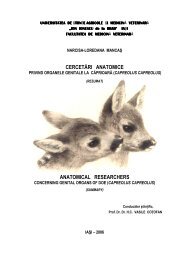
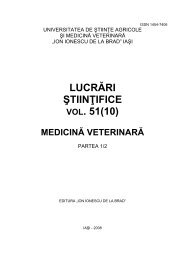

![rezumat teză [RO]](https://img.yumpu.com/19764796/1/190x245/rezumat-teza-ro.jpg?quality=85)
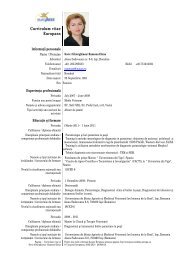



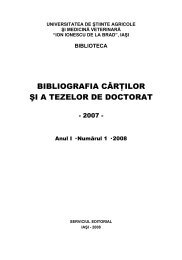
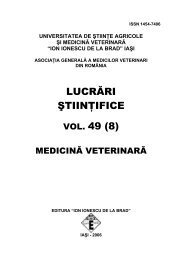
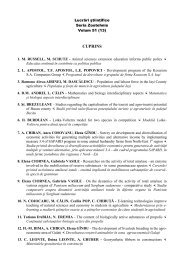
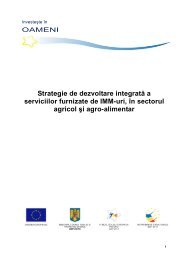
![rezumat teză [RO] - Ion Ionescu de la Brad](https://img.yumpu.com/14613555/1/184x260/rezumat-teza-ro-ion-ionescu-de-la-brad.jpg?quality=85)
